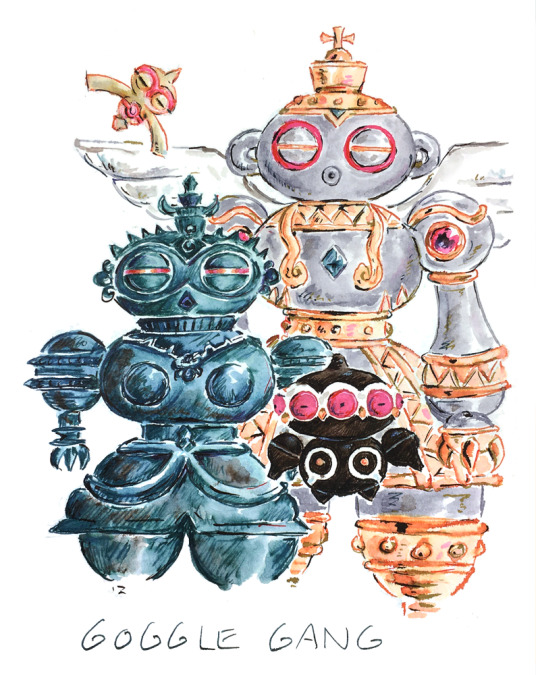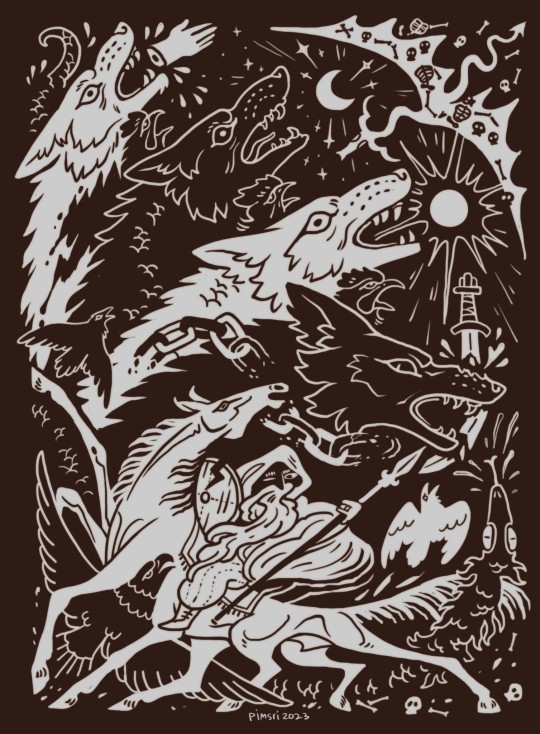Don't wanna be here? Send us removal request.
Text
we know why they like the second most popular strange journey demon, arent we?
that's right! because they are a transgender icon!
A case of twice-mistaken identity: on “Asherah” in Strange Journey
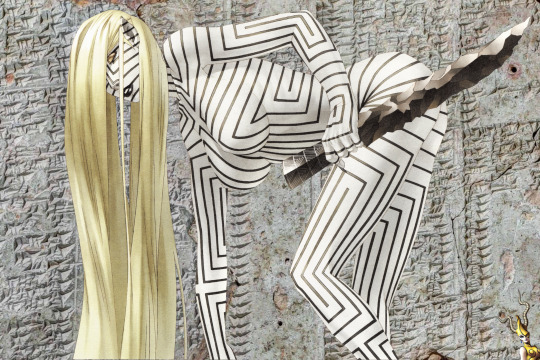
In 2009, Atlus released one of their most unique games to date - Strange Journey, an rpg set in a deliberately unrealistic setting in which demons exist, while the UN does something beyond issuing a non-binding resolution in the face of crisis. In contrast with many of the previous SMT installments, Strange Journey only introduced a handful of new demons. They were some of the last designs Kazuma Kaneko provided for the franchise, but most of them became instant fan-favorites, sparking a veritable avalanche of fanart (by Megaten demon standards, at least) and endless discussion. Going by the raw numbers on pixiv and similar sites, the consensus view seems to be that the standout among them is the “protagonist” of this article, seen above. The English translation of the game, as well as official English translations of all subsequent Megaten media, opted to romanize the name of the discussed entity as Asherah. I have a strong reason to suspect this is wrong, and that “Asherah” is not who most of us assumed she is on this basis. In this article, I will explain the origin of the term asherah and examine if it was ever the name of a deity. I’ll also look through its cognates in multiple languages. Finally, every Megaten fan’s favorite fringe tome will be consulted for additional hints. As a result, the true identity of “Asherah” shall be revealed.
“A horrid thing”: the asherah in the Bible and related sources
The term asherah appears in the Bible, though it’s actually up for debate if it can be interpreted as the name of a deity (Steve A. Wiggins, A Reassessment of Asherah With Further Considerations of the Goddess, p.105). Ignoring occasional modern attempts at emending passages which do not require that, it occurs forty times in scriptural sources (A Reassessment…, p. 110). Nearly all of them point to the asherah being some variety of cultic object. In some cases a plural form is given, though the grammatical gender is inconsistent, with examples of both asherot (Judges 3:7) and asherim (1 Kings 14.23; 2 Kings 17.10; 23.14). The masculine variant is more common, which makes it unlikely the singular form was particularly commonly viewed as a feminine noun - unless, perhaps, the compilers considered an intentionally ungrammatical plural some sort of irony (A Reassessment…, p. 110-111).
Most of the references are fairly formulaic, and occur in passages from books belonging to the tradition of “Deuteronomistic History” explaining why Yahweh became angry with the kingdoms of Israel and Judah. In those cases the anger appears to be tied to placing one or more asherah in the proximity of an altar. Based on the fact that an asherah could be planted, and destroying it was typically accomplished by burning or hewing, most likely they should be understood as wooden objects (A Reassessment…, p. 111-112). Nothing more can be established with certainty, and in absence of precise descriptions labeling any objects recovered from excavations as examples just because they’re wooden should be avoided (A Reassessment…, p. 261).
A possible reference to Asherah understood as a foreign deity might be present in 1 Kings 18:19, where “400 prophets of Asherah” are among Jezebel’s associates singled out by the prophet Elijah (A Reassessment…, p. 127-129). However, it is implausible that this reflects historical reality. Jezebel hailed from Tyre and no deity bearing an even barely similar name is attested in the local pantheon of Tyre - or, for that matter, in any other Phoenician city in the Iron Age (Spencer J. Allen, The Splintered Divine. A Study of Ištar, Baal, and Yahweh. Divine Names and Divine Multiplicity in the Ancient Near East, p. 280).
A further example might be 2 Chronicles 15:16, where at least according to the Masoretes Asherah is used as a personal name. The passage deals with the deposing of queen mother (gebirah) Maakah by king Asa of Judah after she created an unspecified “horrid thing” for Asherah - or, if the Masoretes were incorrect, perhaps created an asherah, a “horrid thing”, for herself (A Reassessment…, p. 125-126).
Rabbinic tradition generally considers the asherah to be a type of tree (A Reassessment…, p. 148-149). Similarly, the Septuagint (and by extension other translations derived from it) renders the plural form of this term as “groves” (A Reassessment…, p. 269). While especially in the 1990s it was common to argue that the hypothetical namesake goddess must have been some sort of tree deity as a result (A Reassessment…, p. 239), no evidence in favor of this interpretation is available (A Reassessment…, p. 261-263). In the end, the supposed arboreal Asherah is little more than a result of overinterpreting a historical guess about the meaning of a term whose original context was entirely lost by the first centuries CE (A Reassessment…, p. 269).

A decorated pithos from Kuntillet Arjud (wikimedia commons)
As far as extrabiblical materials go, the most relevant source offering some further hints about asherah are two early first millennium BCE Hebrew inscriptions from Kuntillet Ajrud in Egypt which mention blessing someone by “Yahweh of Teman and his asherah” and “Yahweh of Samaria and his asherah” (The Splintered Divine…, p. 265). It’s up for debate if “Yahweh of Samaria” and “Yahweh of Teman” were understood as two fully separate deities - the way, say, Ishtar of Nineveh and Ishtar of Arbela were in Mesopotamia - or simply as two regional manifestations of the same deity (The Splintered Divine…, p. 272). The fact that similar formulas find no other parallels in any other texts in Hebrew doesn’t help (A Reassessment…, p. 204). This is ultimately outside the scope of this article, though.
What matters for the discussed subject is that the original publication of the Kuntillet Ajrud material in 1979 sparked what by the early 2000s came to be referred as an “Asherah boom” or “Asherah craze” (Izak Cornelius, The Many Faces of the Goddess: The Iconography of the Syro-Palestinian Goddesses Anat, Astarte, Qedeshet, and Asherah c. 1500-1000 BCE, p. 3).
Crucially, the inscriptions were commonly held as evidence that Yahweh had a wife, and that she was named Asherah (A Reassessment…, p. 190). Nothing explicitly indicates that their authors considered asherah to be the name of a goddess, though (The Splintered Divine…, p. 309).
It is entirely possible that the familiar wooden cultic object is meant (A Reassessment…, p. 198). We might be dealing with a formula similar to Eliezer’s considerably later) invocation of the altar of the Second Temple alongside Yahweh, which obviously does not indicate that he treated a piece of furniture as an independent deity (The Splintered Divine…, p. 309). It might also be worth noting that an asherah was made for Yahweh in Samaria under king Omri’s orders, according to 1 Kings 16:33 (The Splintered Divine…, p. 278).
It should be noted that while one of the inscriptions is accompanied by a drawing (as seen on on the illustration above), it is unlikely to be related to its contents (A Reassessment…, p. 199-200).
It has been argued that a further reference to “Yahweh and his asherah” occurs in a roughly contemporary funerary inscription found in Khirbet el-Qôm in the West Bank, though the poor preservation of the text makes any translations tentative. It cannot thus be used to argue even for a link between Yahweh and the cultic object asherah, let alone for the existence of a goddess named Asherah (A Reassessment…, p. 190-196). It has been argued that it is effectively a Rorschach test of sorts for a given author’s views about the asherah and Asherah (A Reassessment…, p. 274). Ultimately it’s difficult to evaluate if Yahweh ever had a wife, let alone if that wife was named Asherah. If that was the case, it’s hard to disagree that the archeological evidence is beyond sparse, though (A Reassessment…, p. 281).
Looking at material from other nearby areas from the first millennium BCE does not provide any further evidence for a goddess named Asherah. The Phoenician term ʾšrt, which is likely a cognate of asherah, has a handful of attestations (one inscription each from Umm El-Amed, Acre and Pyrgi), but invariably refers to a place - presumably a (type of) shrine or sanctuary - not to a goddess (A Reassessment…, p. 212-214). An alleged Phoenician attestation of Asherah on an amulet from Arslan Tash seems to actually be a reference to the Assyrian head god Ashur, and the object might be a forgery anyway, which would render it virtually worthless as a source (A Reassessment…, p. 210-212).
The supposed Aramaic evidence is even more flimsy. An alleged reference to Asherah (ʾšyrʾ) on a fifth century stela from Tema turned out to be a misreading, with a local deity named ʾšymʾ actually meant. A stela from Sefire does affirm that a cognate, ʾsrt, was used to designate a type of sanctuary, much like in Phoenician, though (A Reassessment…, p. 214-215).
“Lady of the sea”: Athirat in Ugarit
If the evidence for the biblical asherah being a theonym, rather than a term, is flimsy at best, where does the idea that a deity with an identical name existed? To find an answer, we need to travel a few centuries further back than the oldest material discussed in the previous section.
In the early twentieth century, excavations in Ras Shamra in nothwestern Syria revealed that this site was originally a Bronze Age city, Ugarit - and that the local pantheon included Athirat, whose name was suspiciously close to a biblical term for some sort of cultic implement (A Reassessment…, p. 225).
It needs to be stressed that the information from Ugarit cannot be transferred to areas further south in different time periods (The Many Faces…, p. 18). Also, in particular the labeling of Ugarit as “Canaanite” - very common online - should be avoided. It was not located in Canaan - this label only applied to the area more or less from Byblos to Gaza (The Many Faces…, p. 8); it belonged to the circle of Amorite culture (Dennis Pardee, Ritual and Cult at Ugarit, p. 236).
With that in mind, let’s look at Athirat. Her name is undeniably a cognate of the biblical term and its Phoenician and Aramaic analogs. It might very well be that the word originally meant “holy place” or “sanctuary”, and that a theonym developed from it, rather than the other way around (A Reassessment…, p. 221-222). It’s worth stressing right away that Ugarit provides by far the most references to any of the cognate terms which are the subject of this inquiry - Athirat is, ultimately, better attested than asherah (A Reassessment…, p. 105).

Tablet with a section of the Baal Cycle (wikimedia commons)
Athirat is arguably best known from, and most prominent in, the Baal Cycle (A Reassessment…, p. 33). She first appears in the section dealing with the conflict between Baal and Yam, the sea god, though her precise role in the relevant passage is uncertain. She might be involved in providing Yam with a new name or title (A Reassessment…, p. 34-42). Her role in the second of the three sections, which deals with the construction of a palace for Baal, is much better understood. Baal and his ally Anat convince her to mediate with El, her husband, so that Baal can have a house built for himself. Athirat doesn’t appear to be fond of them (in fact, at first she assumes they want to fight her), and convincing her requires numerous gifts provided by the craftsman god Kothar-wa-Khasis. It’s possible Yam, despite already being defeated by Baal earlier, is also present in this scene, and that Athirat temporarily restrains him with a net while her negotiations are ongoing (A Reassessment…, p. 42-74). Athirat makes her final appearance in the third part of the cycle, in which Baal temporarily dies at the hands of Mot. The implied hostility between her and Baal seemingly resurfaces, as Anat remarks that she will surely rejoice after hearing about his untimely demise. El tasks her with appointing a replacement, which she promptly does, choosing Attar to act as a new king of the gods. She seems to be so enthusiastic about this that it has been suggested that it is this opportunity to show off her position this way that’s the cause of her good mood, as opposed to Baal’s death (A Reassessment…, p. 75-77). Athirat’s role is overall less prominent in other literary texts in which she appears. These include the Epic of Keret (A Reassessment…, p. 25-33); Shachar and Shalim (A Reassessment…, p. 86-92); and a variety of shorter or fragmentary compositions (A Reassessment…, p. 92-98). She only occurs with a limited frequency in sources tied to the sphere of cult (A Reassessment…, p. 274).
While none of the Ugaritic texts make that explicit, it can be safely assumed that Athirat was regarded as the wife of El, the head of the pantheon (The Many Faces…, p. 99). Nothing indicates she played this role vis a vis Baal (A Reassessment…, p. 84). The only cases where they occur side by side are offering lists, and this is ultimately as informative when it comes to determining the connection between them as a modern church named jointly after, say, St. Andrew and St. George is for establishing the personal connections of the respective saints (A Reassessment…, p. 101)
El and Athirat have a variety of matching titles, designating them as senior members of the pantheon and creator deities - while El is the “father” and “creator” of the gods, Athirat is accordingly the “mother” and “creatress” (Aicha Rahmouni, Divine Epithets in the Ugaritic Alphabetic Texts, p. 331). The former title only appears once in the entire corpus (Divine Epithets…, p. 73), the latter - six times (Divine Epithets…, p. 276-277).
It needs to be stressed that the “maternal” titles do not designate Athirat as some sort of Frazerian “Great Mother”. They are a reflection of status: she is a creator deity, and a senior member of the pantheon, but not some transcendent all-encompassing ur-mother (A Reassessment…, p. 237). Simply put, she does not represent the popcultural image of a “mother goddess” (A Reassessment…, p. 83-84; The Many Faces…, p. 99).
It is perhaps best to describe Athirat as the divine counterpart of a queen mother, going by her portrayal in the Baal Cycle, especially her role in the appointment of a new king of the gods. It has been argued that her title rbt might specifically reflect this role, judging from the context in which its Akkadian cognate rabītu was used in Ugarit (A Reassessment…, p. 77-78). However, since the sun goddess Shapash is also designated as a rbt, this might be incorrect, at least as far as epithets of deities go (Divine Epithets…, p. 281-282). Athirat’s high status is also reflected by her placement in a trilingual god list based on the Mesopotamian Weidner god list, with Hurrian and Ugaritic columns added. It establishes an equivalence between her, Ninlil and “Ašte Kumurbineve” (Aaron Tugendhaft, Gods on Clay: Ancient Near Eastern Scholarly Practices and the History of Religions, p. 175). The former’s character was similar. She was the wife of a pantheon head, and the epithets highlighting her status similarly refer to her as the “mother” (ummi) or “creatress” (bānīt) of the gods (Divine Epithets…, p. 73). The latter is actually a pure scribal invention, though - the name simply means “Kumarbi’s wife”. No such a goddess was actually worshiped anywhere, she was invented entirely for completeness’ sake (Gods on Clay…, p. 177-178).
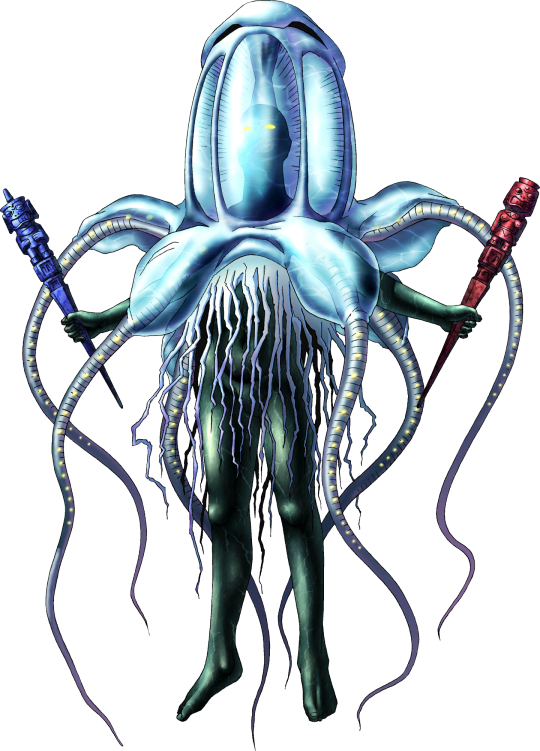
Yam (“Ym”), as portrayed in Shin Megami Tensei (MT wiki, via VeskScans)
Seniority is not Athirat’s only characteristic. Her most common epithet is actually “lady of the sea”, which occurs twenty-one times total - all of those attestations are from the Baal Cycle, though (Divine Epithets…, p. 281). While it contains the same word for sea - ym - as the one which doubled as a theonym, it is agreed that an ordinary body of water is meant in this case, not the sea god par excellence, Yam (Divine Epithets…, p. 284-285). Steve A. Wiggins suggests that the title might be a reference to some hitherto unknown tradition about Athirat’s origin, as opposed to an indication of involvement in unspecified marine matters. While this proposal is interesting, it ultimately remains entirely speculative (A Reassessment…, p. 273). Athirat’s presumed association with the sea might explain why a minor deity consistently described as her servant, Qudshu-wa-Amrur, is addressed as her fisherman (Divine Epithets…, p. 150-151). A further deity defined by a connection to Athirat is Dimgay, her handmaiden, though she is much more sparsely attested (and has no aquatic associations). In the sole text to mention her she is paired with Tallish, who fulfills an analogous role in the court of the moon god Yarikh (Divine Epithets…, p. 78-79).
Excursus 1: the illusory triple A goddess(es)

Anat (right) and her #1 fan, pharaoh Ramses II (wikimedia commons)
While Athirat’s connections with El and with her servants are well documented, a common misconception, repeated especially commonly in older scholarship, but also online, is that she, Anat and Ashtart were associated with each other so closely they basically formed a group. As an extension, the three of them are presented as the only major goddesses in Ugarit (and beyond). However, this grouping is both modern and entirely artificial. It’s worth noting that as far as the Ugaritic evidence goes, Shapash, the sun goddess, was actually comparably, if not more, important as Ashtart (A Reassessment…, p. 230).
Nonetheless, at least among Bible scholars it’s possible to find examples of complete and utter credulity leading to presenting Athirat, Anat and Ashtart as not just closely related, but somehow interchangeable (A Reassessment…, p. 283). Typically questionable publications aim to present Athirat and Ashtart as somehow identical or at least conflated with each other. This is based entirely on the superficial similarity of their Romanized names - they were not very similar in Ugaritic, seeing as one begins with an aleph and the other with an ayin. Ashtart doesn’t even appear in parallel with Athirat; if she is paired with another goddess, it’s Anat (A Reassesment…, p. 57). However, while Anat and Ashtart did share multiple characteristics, even they were not conflated with each other (The Many Faces…, p. 100), let alone with Athirat.

A typical depiction of Qadesh (middle), accompanied by Min (left) and Resheph (wikimedia commons)
Despite lacking any strong foundation in reality, the “triple A” misconception managed to influence early scholarship pertaining to a fourth deity - one who doesn’t even have anything to do with Ugarit, at that. Starting with the 1930s, the idea that the goddess Qadesh must be one and the same as “Asherah” arose. This rested on two far reaching conclusions: that if Qadesh appears with Anat and Ashtart in a single inscription, she must be a foreign goddess of comparable importance; and that qdš (“blessed”) was an epithet of Athirat in Ugarit (A Reassessment…, p. 226).
The first problem is that the sole source to group Qadesh with Anat and Ashtart - the so-called Winchester College stela - is nowhere to be found today. It has been lost at least since the 1990s, if not earlier (A Reassessment…, p. 229). It’s not entirely impossible that it was a fake, since back when it was still accessible to researchers in the 1950s it has been pointed out that the artist had an oddly poor grasp of the hieroglyphic script (The Many Faces…, p. 95).
There is also no evidence that qdš was a title of Athirat (A Reassessment…, p. 226). It does occur as a title of El in the Epic of Keret, though, and is actually grammatically masculine (A Reassessment…, p. 227). Alas, I don’t think anyone is bold enough to suggest Qadesh is El’s drag persona.
A further issue is that while no certain examples of depictions of Athirat have been identified, textual sources indicate she would in all due likeness look considerably less youthful than Qadesh does (The Many Faces…, p. 100). Considering all of these serious obstacles, it should come as no surprise that identifying Qadesh as Athirat largely fell out of favor by the early 2000s (The Many Faces…, p. 95). The modern consensus is that she actually wasn’t fully an “imported” deity in Egypt in the first place, in contrast with Anat and Ashtart. Her name does go back to the root qdš, but she was invented in Egypt (Christiane Zivie-Coche, Foreign Deities in Egypt in the UCLA Encyclopedia of Egyptology, p. 5-6).
Qadesh is first attested during the reign of Amenhotep III (1389-1349 BCE), already in a firmly Egyptian context, on a statue of a certain Ptahankh, an inhabitant of Memphis and affiliate of the priesthood of Ptah (Foreign Deities…, p. 3). It is also known that a temple dedicated to her existed in this city. Her firm position in ancient Egyptian religion is also presumably reflected in epithets such as self-explanatory “eye of Ra” and “great of magic”, a designation for goddesses linked to the pharaoh’s crown in one way or another (The Many Faces…, p. 96). She may or may not have been a love goddess, but no strong evidence in favor of this view exists (The Many Faces…, p. 97).
“Mistress of voluptuousness and joy”: Ashratum in Mesopotamia
While the notion of an association between Ugaritic Athirat and Qadesh is ultimately erroneous, she does have a “relative” who can be considered at least superficially similar: the Mesopotamian goddess Ashratum. While Ashratum can be effectively considered a derivative of Athirat (or, perhaps, a more divergent descendant of a common ancestor), it needs to be stressed that her character differed considerably (A Reassessment…, p. 219). Needless to say, information pertaining to her cannot be randomly applied to Athirat (A Reassessment…, p. 153).

Itūr-ašdum‘s votive inscription (wikimedia commons)
Her character is perhaps best exemplified by the most famous primary source dealing with her, a votive inscription invoking her dedicated to Hammurabi of Babylon (reigned c. 1792–1750 BCE) by a certain Itūr-ašdum. This text describes her as the “lady of voluptuousness and happiness” (A Reassessment…, p. 155-156). This title may or may not hint at involvement in the erotic sphere (A Reassessment…, p. 158). The same term translated her as “voluptuousness” - ḫili - also appears in the ceremonial name of her temple in Babylon, Eḫilikalamma - something like “house of voluptuousness of the land (A Reassessment…, p.163).
As far as I am aware, no study offers a good explanation for why Ashratum came to be associated with the qualities reflected in her title and the name of her temple. However, it has been securely established that her other Mesopotamian characteristics stemmed from her close association with the god Amurru, who was regarded as her husband (A Reassessment…, p. 219). It presumably reflected her own Amorite origins (A Reassessment…, p.153). Amurru (“the Amorite god”) was effectively a personified stereotype - the archetypal nomadic simpleton unfamiliar with urban life, a reflection of the Mesopotamian perception of Amorites arriving from the west (Paul-Alain Beaulieu, The God Amurru as an Emblem of Ethnic and Cultural Identity, p. 33-34). Textual sources indicate that his attribute was a crooked staff (gamlu), possibly originally associated with Amorites on the account of their pastoral lifestyle (The God Amurru…, p. 35-36). To put it in modern terms: you could compare him to a cartoony redneck or hillbilly, complete with a banjo and a jug of moonshine. Except people actually built temples dedicated to him, named children after him, and for all intents and purposes treated him as a valid, if not particularly major, member of the pantheon (The God Amurru…, p. 41-43).
As Amurru’s spouse, Ashratum could be referred to as “tenderly cared for in the mountains”. This is implicitly supposed to be understood as “cared for by Amurru”, seeing as he was regularly referred to as the “lord of the mountains”, bēl šadi (A Reassessment…, p. 158). He could simply be treated as an inhabitant of mountainous areas, though it’s possible his association with this environment doubled as a pun of sorts. The cuneiform sign KUR could be used to write both the word “steppe” (where one would expect to find migrating nomads) and “mountain” (The God Amurru…, p. 38-39).
Amurru’s connection similarly applied to his spouse, and is also reflected in their matching epithets - Amurru was the “lord of the steppe”, bēl seri, while Ashratum accordingly could be called belet seri, “lady of the steppe” (The God Amurru…, p. 38). It should be noted there was another, unrelated Belet-seri, who acted as Ereshkigal’s scribe - seri in this case being understood as an euphemism for the underworld (more about her in my next article). I’m not aware of any cases where the two were confused, barring a possible indirect example - Amurru apparently occasionally appears in the company of some of the goddesses who could be identified as Ningishzida’s wife; and the latter role could be fulfilled by Geshtinanna, who was regularly identified with Ereshkigal’s Belet-seri (Andrew R. George, House Most High. The Temples of Ancient Mesopotamia, p. 37-38). Given the expected difference in demeanor, it is a shame no source has the two belet-seris interact.
The association with Amurru is also why Ashratum could be called the “daughter-in-law of Anu”, the sky god and Amurru’s father. Online an incredibly antiquated interpretation seems to be spreading up to this day (including in Megaten context), with Ashratum misinterpreted as Anu’s spouse. This is the result of a misunderstanding: in both Sumerian and Akkadian, the term “daughter-in-law” (egia/kallatum) can also designate a bride. That simply reflects the fact that typically a father would pick his son’s wife, though - there’s no ambiguity whose spouse Ashratum is supposed to be (A Reassessment…, p. 157-158). Interestingly, a single unique source would indicate that in addition to the happy-go-lucky Ashratum at least some people in the south were aware of her “relative”. A unique Amorite-Akkadian bilingual lexical list published recently explains a-še-ra-tum as DIĜIR.MAḪ, ie. Bēlet-ilī, the "queen of the gods" (Andrew George, Manfred Krebernik, Two Remarkable Vocabularies: Amorite-Akkadian Bilinguals!, p. 115). On textual grounds, it was dated to the Old Babylonian period, specifically to the times of Rim-Sin I and Hammurabi (Two Remarkable…, p. 113). Based on the character of the goddess listed as the Akkadian “explanation” of the name (which you can guess from its meaning), it can be safely assumed that in this case the same deity as in Ugarit is meant - a senior, “respectable” goddess (Two Remarkable…, p. 118).

YBC 2401, the most complete copy of An = Anum discovered so far (Electronic Babylonian Library; reproduced here for educational purposes only) On the opposite end of the spectrum, the considerably later An = Anum appears to treat Ashratum’s section as little more than a wastebasket for any feminine western theonyms, including, inexplicably, Anat (Wilfred G. Lambert, Ryan D. Winters, An = Anum and Related Lists, p. 26). Note she has her own entry in the Amorite-Akkadian bilingual (Two Remarkable…, p. 115). In Ugarit, the trilingual list transcribes her name phonetically in the Hurrian column, and lists (distinctly male) Sagkud as her Mesopotamian counterpart - not Ashratum (Gods on Clay…, p. 176). Interestingly, since Ashratum appears in the original Weidner god list it can be assumed that scribes from Ugarit would be familiar with her thanks to the import of this source. Sadly, we have no clue what they thought about her and her Mesopotamian spouse (A Reassessment…, p. 161).
Excursus 2: odds and ends
A few other names cognate with the biblical asherah, Athirat and Ashratum are not attested well enough to warrant separate sections of their own.
A letter from Tell Taanach in Palestine written in Akkadian (the diplomatic lingua franca in the second half of the second millennium BCE) mentions a deity named Ashirat. This is most likely a reference to the same goddess as the one known from Ugarit. However, the text provides no detailed information about her - it only mentions a cultic specialist in her service in passing (A Reassessment…, p. 170-171). A ruler of Ugarit’s southern neighbor, the kingdom of Amurru, bore the theophoric name Abdi-Ashirta, “servant of Ashirta”. The variant form Abdi-Ashratum is also attested, so we are pretty clearly dealing either with another form of the name of one of the previously discussed goddesses, or a further deity with a cognate name. The matter is complicated by the fact that multiple times the name is written with typos by Egyptian scribes with only a rudimentary understanding of cuneiform, though (A Reassessment…, p. 168-169).
An apparent Hittite adaptation of the Ugaritic Athirat, Asherdu (sic), is attested exclusively in a short myth in which she and her partner in crime Elkunirsa (an adaptation of El, as you can probably guess) plot against a weather god of uncertain identity. The last of these characters clearly takes Baal’s role, but his precise identity cannot be established, as he’s only referred to with a generic logogram which could designate different weather gods, not with a given name. The entire composition might be based on some hitherto unknown southern forerunner, but not much can be said about its development beyond that (A Reassessment…, p. 172-175).

An example of Qatabanian script (wikimedia commons); no relation to cuneiform.
Finally, a handful of references to a more distant “relative”, Athrat, have been identified in texts from the kingdom of Qataban in Yemen dated to the second half of the first millennium BCE; she is thus separated from Athirat, Ashratum et al. by both a temporal and spatial gulf (A Reassessment…, p. 187). The available sources don’t provide much information about her. Two mention a temple she shared with Wadd, a local moon god, while another relays she received offerings alongside ‘Amm, the national god of the kingdom of Qataban (and possibly also a moon god). The nature of the precise connection between her and those two, and in particular whether she might have been viewed as the spouse of either of them, or even both (perhaps in different locations within the kingdom), is a subject of debate (A Reassessment…, p. 180-181). If she was, she might have been viewed as a solar goddess, though that remains uncertain (A Reassessment…, p. 186). The fact that it’s possible in some of the Qatabian inscriptions a structure is meant, and not a goddess, does not help much with the evaluation of the scarce evidence (A Reassessment…, p. 177-178).
��Genital center”: Asherah according to Barbara G. Walker
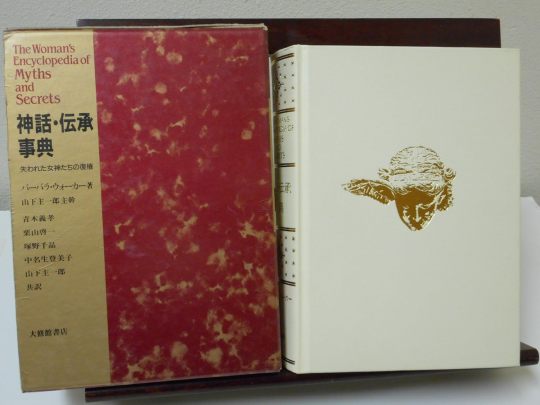
The Japanese edition of Walker's book (via an expired online listing with an asking price of 600+ USD [sic]; reproduced here for educational purposes only)
The previous sections more or less summarized what actual scholarship has to say about the term asherah and its cognates. However, with Megaten being Megaten, this is insufficient . No inquiry is complete without also consulting Atlus’ favorite publication: Barbara G. Walker’s magnum opus The Woman's Encyclopedia of Myths and Secrets.
Evidently not only Atlus is enamored with her writing - it has influenced a number of other popular Japanese franchises, especially Fate. It also has overwhelmingly positive reviews on Goodreads. There is a non-trivial number of people out there who find it credible, despite the author’s complete lack of relevant credentials, poor sourcing, and questionable at best methodology. Ironically, I have a strong suspicion that Walker herself might no share this view. I’d hazard a guess that this tome - and Walker’s numerous other less discussed New Age publications, including such smash hits as I-Ching of the Goddess - are a cynical grift, since she describes herself as an atheist elsewhere (sic). I digress though.
Walker’s book contains a total of 29 references to Asherah. She gets her own separate entry, but it surprisingly only occupies one page. To be fair, we have to bear in mind that in the early 1980s, when the book was written, the “Asherah boom” was only starting. Most of the entry is not particularly unique, and is limited to Bible-based speculation from before the discovery of the “Yahweh and his asherah” inscriptions, with a dash of Ugarit. Walker basically subscribes to the notion of a “tree goddess” wholesale, and adds that clearly the “groves” were a metaphor for Asherah’s “genital center”. She had to throw in something uniquely baffling, though, and speculates the name Asherah somehow goes back to Old Iranian asha, which she translates as “universal law” (for the actual meaning of this term, consult Encyclopedia Iranica). Further, she connects her with Isis at random, and asserts she was worshiped in Thebes as a result (The Woman’s…, p. 66).
Elsewhere in the book Walker simply rehashes questionable dated scholarship of the sort already discussed earlier. She proclaims Asherah and Baal a couple (The Woman’s…, 85); in Anat’s entry she treats her and Asherah as interchangeable and, inexplicably, also as the goddess of Jerusalem (The Woman’s…, p. 30). Astarte gets similar treatment (The Woman’s…, p. 69). This identification also gets an extended version which includes Aphrodite and Lucian’s Dea Syria as bonuses (The Woman’s…, p. 44). As far as I am aware, the identification with Aphrodite is a Walker original. She liked it so much it also pops up in Adonis’ entry, where she explains he was paired with “Aphrodite or Asherah” in Mesopotamian Mari (The Woman’s…, p. 10). This sort of complete disregard for temporal (Mari ceased to exist in Hammurabi’s times) and linguistic rigor is a mainstay of her work. Interestingly, Walker appears to be entirely unfamiliar with Ashratum, and instead asserts that the Mesopotamian counterpart of “Asherah” was Ashnan. She describes this name as Sumerian (The Woman’s…, p. 66). In reality, Ashnan’s name is Akkadian and means “grain”; the same goddess’ Sumerian name was Ezina - which, as you can imagine, also means “grain” (Julia M. Asher-Greve, Joan Goodnick Westenholz, Goddesses in Context: On Divine Powers, Roles, Relationships and Gender in Mesopotamian Textual and Visual Sources, p. 41). Needless to say, she had nothing to do with Ashratum.
Conclusions: Asherah, Athirat, or Ashratum?
With both the credible and questionable sources summarized, it is time to finally try to figure out who the “protagonist” of this article is supposed to be.
The translators of Strange Journey evidently concluded they’re dealing with the sort-of kind-of biblical figure. The assumption that’s who “Asherah” is supposed to be is common among English-speaking fans, and recently made it to her entry on the new Megaten wiki, which proclaims the discussed entity was “depicted as the wife of (...) Yahweh” (which, as I already pointed out, is at best a theory). As some of you might remember, in the past even I accepted it, and it was quite surprising to me that Atlus - with the well known love of dubious material, and a penchant for making everything revolve around YHVH which if anything only grew in more recent instalments - did nothing with this in Strange Journey. Or in any other game, for that matter.
I think the answer why that never happened is simple: “Asherah” was never meant to be who the romanization made her. It’s a case of mistaken identity.
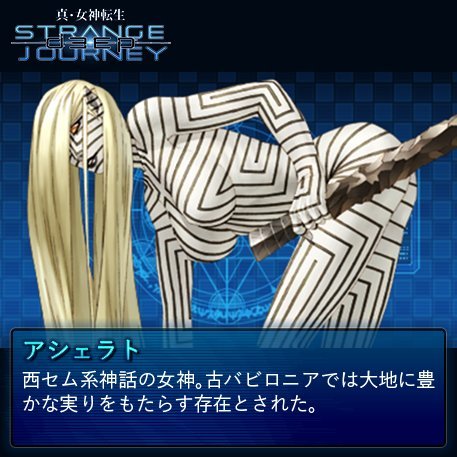
As demonstrated on the screencap above, the name used in the original game, as well as in SJR and subsequent SMT installments, is spelled as アシェラト in katakana. A quick search will demonstrate that the biblical term is actually rendered as アーシラト - that’s the spelling Japanese wikipedia uses, for instance.
Who is アシェラト, then?
While this might not be evident at first, apparently the conventional Japanese spelling of Ugaritic Athirat. Japanese Wikipedia claims so outright, though without providing sources. However, I think we can trust it in this case. Most of the relatively few non-Megaten results for アシェラト appear to come from Ugarit hobbyists, here is just one example; I can vouch for this person’s credibility, they are pretty clearly well acquainted with the primary sources and relevant scholarship.
This impression that Athirat, not Asherah, was the intended name is further strengthened by the romanization of the name used in Shin Megami Tensei Series 25th Anniversary Memorial Book: MegaTen Maniacs, a book released as a bonus with a limited edition of Strange Journey Redux (p. 133; thanks to @purseowner4thequalityanimation for directing me to it!):

This is far cry from Asherah, but remarkably close to the non-vocalized form of the Ugaritic Athirat’s name, aṯrt. However, the name is not all. The compendium entries also provide some clues. Her original one describes her as “a Semitic goddess who was the one to bring fertility to the Babylonian lands. She is known as the mother of the gods. It is believed that in Phoenicia, she became Astarte.” I’m not a huge fan of implying there ever was such a thing as a “Semitic pantheon” - only languages can be described as “Semitic”, deities, let alone a “religion”, not really (Michael P. Streck, Semites, Semitic in RlA vol. 12, p. 386-387) - but the information, by Megaten standards, is relatively rigorous. We get a mix of Ugaritic Athirat (“mother of the gods”) and Mesopotamian Ashratum (explicit reference to Babylonia), with the questionable conflation with Ashtart (Astarte is simply the Greek spelling of this name) I mentioned thrown in for good measure. No references to the Bible or the inscriptions which sparked the “Asherah boom” are present, though.
Perhaps most curiously, even if not ideal, the sources consulted were clearly of much higher quality than Woman’s Encyclopedia - which, in fact, seemingly didn’t have any impact on Asherah’s bio. Mashing Ashratum and Athirat together is questionable, much like mashing together, say, Zeus and Tyr based on the shared origin of their names would be, but it’s miles ahead of many other choices made by Atlus. SMT IV didn’t change much. She appears in an NG+ quest which presumably reflects Atlus’ love for unnecessary equations - in this case with Ishtar. The less said about that, the better.
When Asherah was later added to Dx2 - which for now is her final appearance in the series - she received a new compendium entry, which describes her as “a goddess from ancient Semitic religion, married to the Lord of the Mountains Amurru. She is thought of as the Mother of all Gods. As the goddess of love and fertility she was worshiped in ancient Babylonia. She is also known as Astarte in other religions.” Most of the information from the previous version returns, but we have a surprising case of doubling down on the reference to Mesopotamia - with a surprisingly accurate reference to Amurru thrown in. Once again, no trace of Yahweh, biblical cultic objects, or anything of that sort, though. Walker’s influence also cannot be detected. Later on, the Ugaritic material got an additional shoutout in Dx2 - with the advent of a feature letting the player turn spare demons into equipment, the option to turn Asherah into a sword with the ability “Lady of the Sea” was added. It should be noted that Dx2 later did throw the Bible into the mix, though - a craftable shield from the same update is named Asherah Pole, an obvious reference to the cultic objects discussed in the first section of the article. Still, I believe I’ve conclusively demonstrated nothing indicates that was the intent when the design was created for Strange Journey.
To sum up, ignoring the single outlier from Dx2, “Asherah” appears to be a mashup of the Ugaritic Athirat and Mesopotamian Ashratum - with the name clearly pointing at the former. That, at the very least, should be the romanization of it. I do think this adds a second layer of mistaken identity - Athirat and Ashratum have cognate names, but their character is dissimilar, and they were worshiped in different areas - but once again, the series has seen much worse.
My only problem with treating “Asherah” as Athirat is her design. It’s not that I necessarily dislike it (quite the opposite). It’s striking for sure, and its position as a fan favorite is well earned. I won’t delve into speculation whether the popularity boils down to Asherah being a large scantily clad woman covered in geometric patterns who’s easier to draw than fellow scantily clad large woman covered in geometric patterns Maya, and more prominent than fellow scantily clad and covered in geometric patterns (but not necessarily large) Cybele (who’s not in the base SJ which is beyond bizarre to me given that the game is a joyful tribute to Frazerian phantasmagorias by the way of Barbara Walker, but I digress). To be entirely fair, there isn’t really anything I could compare it to. No unambiguously identified iconographic representations of Athirat or Ashratum - let alone of the hypothetical “Asherah” - exist (A Reassessment…, p. 264). The so-called “pillar figures” are frequently labeled as “Asherah” (even in her wikipedia article), but for no particularly strong reason (A Reassessment…, p. 267).

Baal Cycle beach episode (personal screencap from 2021 or so; I do not recommend actually playing the gacha)
A question we should ask ourselves is whether it’s possible to imagine her playing her role from the Baal Cycle, given that it’s the most extensive source dealing with either Athirat or Ashratum. Despite never really adapting it, Megaten somehow managed to give us nearly the complete cast - and I would argue Baal, Anat, Yam, Mot and Attar all look like they could pull off their roles from this cycle of myths. How about “Asherah”? In theory she could, I suppose, though I personally would prefer Athirat to look visibly older, and somewhat less naked (I quite like this one). As the Mesopotamian Ashratum, the design would work perfectly fine, though. I will refrain from trying to evaluate whether the Old Babylonian official who called her the “mistress of voluptuousness and joy” would be fond of the contents of her pixiv tag, but I think her appearance represents this description pretty well.
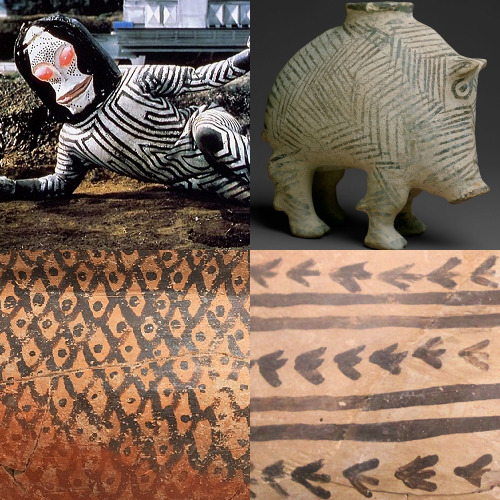
The alien Dada from Ultraman, an Elamite boar vessel (via MET) and two pieces of Halaf ware (wikimedia commons)
As a side note, while Asherah’s coloration and patterns ultimately simply reflect Kaneko’s enthusiasm for an abstract art themed alien from Ultraman (I suspect the size does too), they unintentionally(?) make the “heroine” of this article resemble painted pottery - which works well enough, I think.
Post scriptum: Asura in Strange Journey
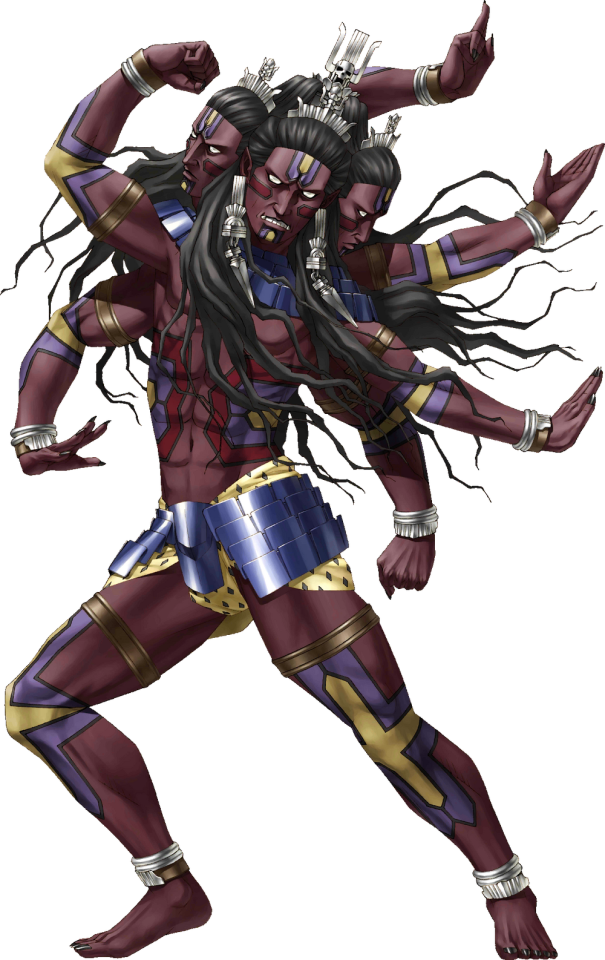
Asura, as portrayed in Strange Journey (MT wiki, via VeskScans) An article dealing with Asherah in Strange Journey - even one focused on different aspects of her role in the game - cannot leave out perhaps the most puzzling choice made during its development. I am referring, of course, to having Asura turn into her. Apparently a few years ago an assumption that Barbara G. Walker might be to blame was making rounds, though this is, surprisingly, entirely baseless (as documented here). My suspicion is that this has nothing to do with Asherah, and instead is a leftover of an earlier version of the game.
As revealed in the already discussed Megaten 25th anniversary book, Asura was initially supposed to turn into Ashur, the tutelary god of the city of Assur, and by extension Assyria as a whole (Megaten Maniacs, p. 133).
While there’s no deeper connection between the two other than a superficial phonetic similarity, presenting them as closely related is not actually not an invention of Atlus either. The notion that the Hindu Asuras have something to do with Ashur, or at least with Assyria more broadly, enjoyed some renown in the early decades of the 20th century, though even then wasn’t universally accepted (Hannes Sköld, Were the Asuras Assyrians?, p. 265-266). Today it is kept afloat largely just by all sorts of fringe websites, including but not limited to puzzling Hinduism-adjacent blogs and Atlantis truthers (are there people searching for the location of Hobbes’ Leviathan too?). Presumably, someone at Atlus found it in a similarly dubious source.
Ashur obviously didn’t make it into the actual game, and Asherah took his spot for some hitherto unknown reason. As per the same source (ie. Megaten Maniacs, p. 133), multiple other demons were replaced at some point in the game’s development. Interestingly, Ashur and Asura are the only case of only one half of a pair being replaced. Morax and Moloch were added as a replacement for Minotaur and Asterius, while Mithras and Mitra - for Asmodeus and Aeshma. Both of the scrapped pairs are closely related thematically: Asmodeus is a Jewish take on Zoroastrian Aeshma in origin; Asterius in this context was presumably intended as Minotaur’s actual given name (as given for example by Pausanias), and not one of the numerous other bearers of the same name in Greek mythology.
It sounds a bit as if some of the changes were done in a hurry. Going beyond the pairs, Ouroboros was supposed to be replaced by but they apparently failed to find someone appropriate - a figure with ma in the name who could take an “administrative role” among the mothers - on time (I think Ninimma would work - she has ma in her name, disputed claims of a “maternal” or “creative” role, and she clearly would work well as an “administrator” - but I digress). Even Mastema almost got replaced at the last minute. The developers apparently worried about his appeal to the potential audience, and considered replacing him with another angel, though no more precise information is provided. Given that he’s easily one of the most popular demons today this sounds pretty silly in retrospect.
Could it be that Asherah’s introduction was a last minute change like that? Perhaps Asura remained simply because there was no time left to design a more fitting demon to go with her (not that he was a particularly good match for Ashur in the first place)? These questions must remain unanswered, unless by some miracle more information about SJ development will emerge in the future, sadly. I feel obliged to point out that the Ashur case might've been a rare example of a situation in which Atlus could’ve instead just resorted to one of the series staples to make it more coherent. I’m talking, of course, about the persistent conflation of Asura and Ahura Mazda (as recently discussed by Eirikr here; note that even Asura’s SJ compendium entry brings it up).
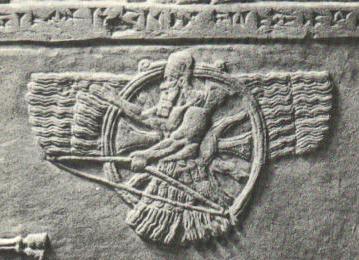
The Assyrian god inside a ring (wikimedia commons)

The Achaemenid figure inside a ring (wikimedia commons) A connection between Ahura Mazda and Ashur, while not directly attested, is a fairly common subject of speculation in scholarship up to this day. To be specific, a symbol common in Achaemenid art, a winged figure inside a ring, is argued to be a representation of Ahura Mazda patterned on earlier Assyrian depictions of a god usually interpreted as Ashur (Michael Shenkar, Intangible Spirits and Graven Images: The Iconography of Deities in the Pre-Islamic Iranian World, p. 47-50; note that identification with Shamash is also relatively common, though).

A possible eastern depiction of Indra-like Ahura Mazda (left) with Nanaya (center) and Weshparkar (right) from Dandan Oilik (wikimedia commons) While Zoroastrianism is, at least nominally, aniconic, historically especially in the peripheries of the areas inhabited by its adherents (like the Caucasus or the western frontiers of China) the borrowing of iconography from neighboring cultures was frequent. The possible Ashur-Ahura Mazda depictions have less ambiguous parallels involving the iconography of Zeus (in Commagene, in Bactria, and on Kushan coins; Intangible Spirits…, p. 61-62) and even Indra (in Sogdia, sometimes complete with elephant mount; Intangible Spirits…, p. 63) being adopted to represent Ahura Mazda. I guess Ronde gets the last laugh here: the bizarrely Zeus-like Ahura Mazda accidentally turned out to be pretty accurate.
#asura#asherah#athirat#shin megami tensei strange journey#and maybe because of gooners#maybe its also that
172 notes
·
View notes
Text
tvs in gay bars
420 notes
·
View notes
Text
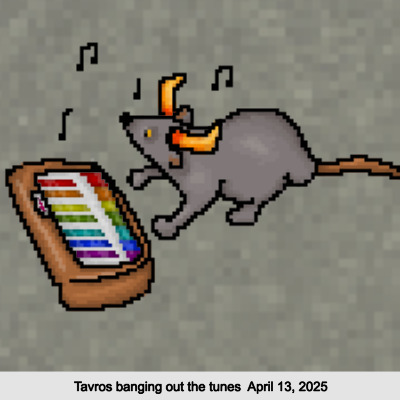
neil banging out the tunes homestuck style
7K notes
·
View notes
Text
Makes you wonder why he choice miho as a kamen rider (making her the first official female rider because fuck tackle i guess) unless he somehow thought miho was some very sexy dude and give her a card deck.
Kinda gay for Shiro Kanzaki to start the Rider War and then proceed to pretty much only pick hot guys for it like OK dude
163 notes
·
View notes
Text
Kinda gay for Shiro Kanzaki to start the Rider War and then proceed to pretty much only pick hot guys for it like OK dude
163 notes
·
View notes
Note
honestly a Warhammer collab could be kinda neat (though im mostly familiar with 40k) i like the concept of a space marine screaming "HERESY!!" when he see japanese teenagers summoning demons
Putting aside outliers like Sonic, what series would you think would be a good fit for a Dx2 collab?
Something that immediately comes to mind is Court of the Dead.It's basically a collection of lore to sell expensive statues and other merch of its collection of characters, but I like some of its designs:




I can't say I'm really in to the property, whose best days seem behind it, but it's more or less the American equivalent in quality/tone to the less-than-stellar JP series you'd see Dx2 collab with, like Seven Deadly Sins.
Ah, Dx2, you're the perennial "break glass in case of SMT main series doldrums," such as what we're in now.
5 notes
·
View notes
Photo
Holy shit Kamen Rider Accel game


‘Kinetica’! A PlayStation 2 game where your body is the bike! The game actually came with a little art book too! This is the American cover artwork.
#Kinetica#kamen rider#kamen rider w#Kamen rider accel#Ps2#PlayStation 2#or consider this predates W#Accel is a Kinetica Kamen Rider#Ryu terui
256 notes
·
View notes
Photo

‘Kinetica’! A PlayStation 2 game where your body is the bike! The game actually came with a little art book too! This is the American cover artwork.
256 notes
·
View notes
Text
SMT Boardgame Kickstarter Smells Like Suspicious Fish

There's an SMT boardgame. Curb your enthusiasm, you shouldn't back it. And if you did, lower your pledge to like a buck until they clear things up, because as it stands it seems like an incredibly suspect product.
Checking through the Kickstarter comments and Japanese Tweets about the boardgame makes the entire thing seem poorly planned at best. I'll summarize as best I can;
The designer is incredibly infamous in the boardgame community
Naoki Matsunaga, a self-described "board game sommelier", is the designer. You'll find tweets lamenting that "the board game sommelier is involved". Why is he so hated? This thread goes into detail: co_boze on twitter. Part of it is they bashed Werewolf over one game they saw of it, another is they took on a kind of public-face role for boardgames appearing on late night TV shows to talk about them in ways that annoyed boardgamers. They seem to have designed a boardgame based on "The 7 Habits of Highly Effective People" which ripped off Sid Sackson's 'I'm the Boss". But it's what co_boze talks about next that's really bizarre. The game was apparently banned from most board game cafes and playing spaces. Seminars where people could play the game were hosted, but the venues that hosted these seminars all closed down.
If you keep looking through comments, you start finding claims that his company does multi-level marketing (ie pyramid schemes). To be honest, I don't know if this is true. But even if it isn't, it is really not hard to find people who know of this guy and would really really really REALLY prefer he was not involved.

"Oh fuck, it's THIS guy" is not a reaction that inspires confidence
2. Questionable development and presentation issues.
A regular collaborator with Atlus recently tweeted "The use of AI in Atlus works or derivative works is stictly prohibited." He responded to a reply asking if this was about a board game.

The staff running the SMT BG Kickstarter later clarified the actual -game- wouldn't use AI graphics... but from the looks of it, the promotional materials do.

Dig that... generic metal pipe aesthetic. Nothing screams MegaTen like black plumbing to nowhere.
In totally unrelated news, a board game manufacturer recently tweeted that a Kickstarter used their name without permission, and they're not sure why.
Quote tweets on the post would suggest it was the SMT board game. The comment they are loosely referring to is this:

In a follow-up post, they do specify "The product figures will be made of PVC." and "We will be manufacturing the games in partnership with a factory in China that has a proven track record... " "Figure director Kimura Yuzuru has over 10 years of experience..." and other boring development stuff that I have no issue with. What I do have issue with is how they can say things like they're "considering" which manufacturer to use and namedropping other companies that they're unrelated with. (While I was typing this post, they posted an update that clarified the CMON issue and literally nothing else: here.)
The boardgame is being presented with machine translated English printed on the same cards as the Japanese. But the actual game will have a translator check everything.

they hire translators to localize all game content

Additionally, there was a week long radio silence on the Kickstarter. For reference, Kickstarters are normally very active with the project planners dropping updates, responding to feedback and clearing up any concerns.
Some of the concerns were "How does the game actually play?", a question that would be best answered by dropping a rulebook for people to look at, or better yet showing them an entire run of the game. The SMT BG Kickstarter has boldly chosen neither. Devs have commented the game is on Version 11 and plays well, which makes it strange that they can't share any of it with anyone else.
Actually, when you compare this to how most Kickstarters are run, it becomes very clear the SMT BG Kickstarter is, uh, kinda failing in all possible regards. The first Backer Goal is "Jack Frost Dice" at 2000 backers (not funds raised, BACKERS). Despite getting 300%(!!!) of the initial pledge needed, there are no bonuses or unlocks.

Mind, this lack of information comes after they already delayed the start to supposedly improve Backer Goals and other aspects.
There aren't a shortage of issues - it's ICREA's first boardgame (but not their first tango with SMT; they made the SMT30th Logo, for instance.) The timeline seems totally wack. The staff have been incredibly slow to respond. Cards with tiny font and two languages printed on them. Etc, etc. Maybe individually these issues wouldn't be too concerning. But all of them combined make the product seem incompetently run at best, and at worst an actual scam.
I'm hardly a big influencer in the SMT scene (my biggest contribution is when that fucking succubus gif gets 36k likes on Twitter every 5 months) but I haven't seen any English speaking sources discuss this in detail, when there really should be at least some noise about all of this. Still. if just one of you end up saving 600 bucks on what ends up being a trashfire carcrash project because of this post, then that'll have made the past 30 minutes of typing this shit worth it.
#shin megami tensei#smt#damn#i was excited until vesk said the game did you AI but not in the final product#but i know im awared of this#fuck this
168 notes
·
View notes
Text

Would you still love me if I was the official Kamen Rider Ryuki Chess Pcs (12pcs) by MegaHouse
#kamen rider#kamen rider ryuki#chess piece#OMG#also asakura as a queen is actually perfect he's a total girlboss#born to be a diva#i want one but i bet like demon's chronicles it is expensive
247 notes
·
View notes
Text




There are so many different Amazons (I am very sorry Wikipedia).

(I am not entirely sure what "vinaceous" means, was not in the dictionary. But I think it means "wine-colored".)
500 notes
·
View notes
Text

The 2003 PlayStation 2 RPG Shin Megami Tensei III: Nocturne contains unused dialogue seemingly spoken by Luigi in its files. It is part of a text file containing placeholder messages for a negotiation system, with the Luigi message being called "DUMMY_SUCCESS_INFO", indicating that it was a placeholder for succeeding in persuading a character to divulge information.
Why Luigi was chosen for this is unclear, especially due to the lack of Mario references in the rest of the game and code.
Main Blog | Twitter | Patreon | Small Findings | Source: 1, 2: despiriaSEGA
3K notes
·
View notes
Text









Screenshotsofdespair: Assorted Kamen Rider Edition
162 notes
·
View notes
Text
Random sketches of the day/night

#MY HYPERFIXATIONS#HOLY SHIT#kirby#kirby series#Final Fantasy IX#Shin Megami tensei#shin megami tensei iii nocturne#Shin megami tensei V#Megaten#megami tensei#SMT
26 notes
·
View notes
Text
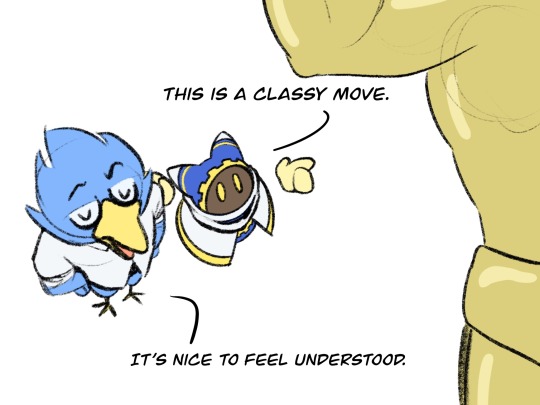


Berdly and Magolor are the same guy with varying levels of pathetic-ness and they NEED to hang out
#HOLY SHIT#BIRD EGGBERT WITH EGG CAT WIZARD#you lighting my timeline#are they called timelines?#kirby#magolor#kirby series#deltarune#berdly#queen#queen deltarune
1K notes
·
View notes
